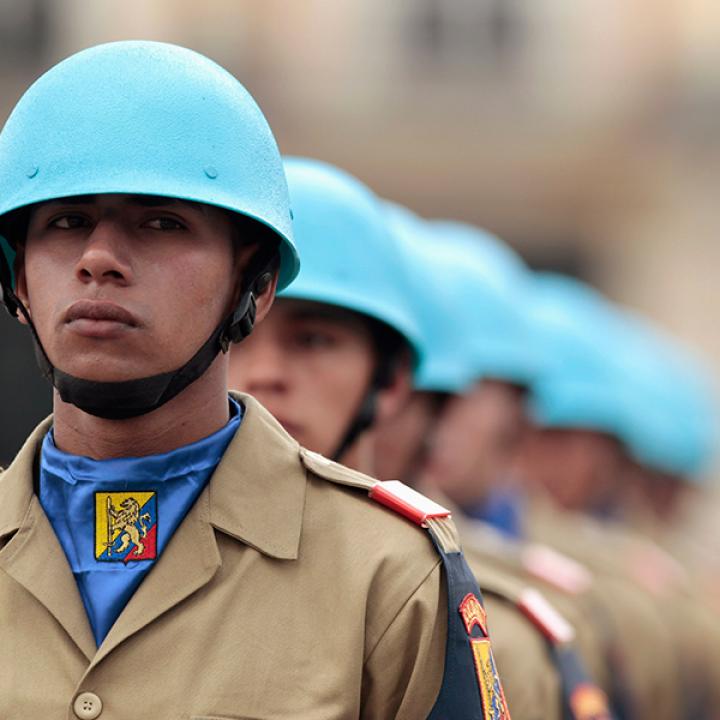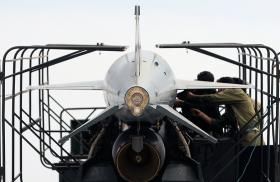

Although improved Egyptian-Israeli cooperation and enhanced remote-monitoring technologies will ease the pain of the planned drawdown in Sinai peacekeepers, the situation will only worsen unless Cairo adopts a more appropriate counterinsurgency strategy.
Since 2012, the persistent Islamic State-led insurgency in the Sinai Peninsula has encouraged unprecedented military cooperation between Egypt and Israel. This trend is a major reason why senior officials from both countries almost universally acknowledge that bilateral relations are the best they have been since the signing of the peace treaty in 1979. The security rapprochement is particularly timely because recent Islamic State military gains in the Sinai spurred the United States and its partners to redeploy the Multinational Force & Observers away from the border in the interests of force protection. While some MFO troops will still be stationed in certain areas, the peacekeeping force will rely much more heavily on technical means to monitor the situation from a distance, with uncertain long-term implications for Israeli-Egyptian relations.
BACKGROUND
The MFO has been monitoring the security provisions of the Camp David Accords since 1982, focusing on "Zone C," the roughly one-fourth portion of the Sinai that runs along the border with Israel. The force currently comprises around 1,700 military personnel and a few dozen civilian officials supplied by twelve countries; 707 of these personnel hail from the U.S. military, including the Infantry Battalion Task Force and the logistics unit that conducts air operations. Washington also provides nearly a third of the MFO's $86 million annual budget, as well as supplemental force protection funding and mine-resistant ambush-protected (MRAP) vehicles (for more background, see "America's Least-Known Mideast Military Force").
At one time, a posting to the MFO was a coveted assignment that meant relatively safe observation duties coupled with frequent trips to the peninsula's pristine beaches. To be sure, no deployment is risk-free -- in 1985, 248 U.S. soldiers from the 101st Airborne Division were killed in a plane crash on their way home from the Sinai, and a 2007 crash killed nine French and Canadian peacekeepers. Yet the MFO did not encounter serious threats on the ground until the past decade.
DETERIORATING SECURITY
The Sinai security situation first showed signs of evolving in 2005-2006, when Bedouin militants began attacking MFO vehicles and personnel with roadside and suicide bombs. These and other attacks have increased since the 2011 ouster of President Hosni Mubarak and the onset of full insurgency in the peninsula, with Islamist extremists joining the fray. In 2012, Bedouin infiltrated the MFO's North Camp, wounding four peacekeepers. A year later, a U.S. serviceman was shot near the camp's entrance. In June 2015, the MFO's airport at al-Gorah was shelled. And two months later, an improvised explosive device planted by Islamic State operatives wounded six MFO troops, including four Americans (for more on the terrorist group's impact on the conflict, see PolicyWatch 2478, "Securing the Sinai MFO Without a U.S. Drawdown").
The latter attack spurred a policy reevaluation in Washington. Despite the overwhelming Egyptian military force arrayed against reportedly less than 2,000 Islamist insurgents, Cairo had made no progress in rolling them back after five years of fighting. Instead, Egyptian forces had suffered severe setbacks, caused excessive collateral damage, and lost over a thousand policemen and troops in the Sinai. Today, insurgents continue to attack static military and police positions almost weekly.
The Obama administration has seemingly reached the conclusion that Cairo lacks the will to clear and hold territory in the Sinai. Worse, Washington lacks confidence that the Egyptian military, even if asked, would take steps critical for MFO force protection, such as demining roads leaving North Camp. To wit, the MFO announced last September that it had removed personnel from a site just five kilometers from the camp "as a result of an inability to safely resupply the site and continue conduct of its mission from that location." As one U.S. noncommissioned officer recently told a reporter, "North Camp was very similar to Afghanistan...You could hear the action going on outside the wire. Mortars and stray rounds came flying in randomly and alarms went off a few times a week. It was dangerous."
In September, the administration dispatched an additional seventy-five troops to beef up force protection capabilities. Recognizing that this was inadequate, the MFO soon curtailed observation operations and began consolidating troops at South Camp in Sharm al-Sheikh. Last month, Washington announced that it would reconfigure the force.
THE MFO REBOOTED
While details of the restructuring have not yet been released, its emerging contours suggest a heavy emphasis on force protection. The Force Commander's Headquarters and most of the troops may be moved to South Camp, minus perhaps a small contingent left behind to secure assets in North Camp. According to the MFO, South Camp can currently accommodate around a battalion-size force (roughly 800 troops), so it may have to be expanded. The observers on the Red Sea islands of Tiran and Sanafir -- whose sovereignty Egypt recently transferred to Saudi Arabia -- may remain in place, since the outposts are surrounded by miles of water and are considered safe. At the same time, the MFO as a whole will almost certainly decrease in size.
This downsizing will be made possible by increased reliance on automated and/or remote monitoring systems, perhaps including ground-based video cameras, radio direction-finding equipment, aerostat-mounted cameras, commercial and government satellite imagery, and aerial imagery captured by Cyprus-based U-2 aircraft, which have been observing the Sinai since 1973. The ground-based systems would require personnel to carry out routine maintenance, and some soldiers might be periodically needed to observe Egyptian troop movements in locations where passive monitoring systems are impractical. Overall, however, the replacement of MFO observers with technical means will make substantial troop reductions achievable.
IMPLICATIONS
While the MFO price tag for the United States may be marginally reduced, Washington's peace partners are comfortable with the large American presence in the Sinai and are likely to agitate against a large-scale withdrawal, even amid continually improving Egyptian-Israeli security relations. The lesson of the Egyptian Revolution is that things in Cairo can change quickly -- in 2012, for instance, the Muslim Brotherhood government of President Mohamed Morsi deployed a tank battalion to the peninsula without first obtaining clear Israeli consent. Although Israel later approved such deployments and has been working with Cairo more closely since Morsi's ouster, it is likely still keen on avoiding a dramatic U.S. drawdown.
During an April 12 press conference, State Department spokesman Mark Toner repeatedly noted that the planned MFO restructuring was "not about responding to...the threat of ISIL on the ground." Yet the nature and timing of the administration's initiative clearly suggest otherwise. The Egyptian military is neither containing nor rolling back the terrorist group; in March, a single Islamic State attack killed thirteen of its soldiers, and three officers were killed a month later. Insurgents are also attempting to plant roots west of the Suez Canal -- just last week, Islamic State fighters reportedly killed eight policemen in a Cairo suburb.
Given developments in North Sinai and the new technologies available, restructuring the MFO makes sense. Yet while South Sinai is more secure than the north, threats persist there as well -- only seven months ago, the Islamic State downed a Russian civilian airliner departing Sharm al-Sheikh, killing 224 people. Given the area's importance as a tourist destination, Cairo will likely prioritize security in the south (Sharm al-Sheikh in particular) to help salvage this critical and moribund economic sector.
Even so, the Egyptians will still need outside guidance. To help preserve quiet in the south and reestablish security in the north, Washington should press Cairo more forcefully on accepting U.S. training and shifting its procurement focus to better enable a modern counterinsurgency (COIN) approach to the Sinai. If Egypt does not reverse the insurgency's trajectory, the next MFO redeployment may be out of the peninsula entirely.
David Schenker is the Aufzien Fellow and director of the Program on Arab Politics at The Washington Institute.



